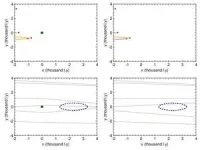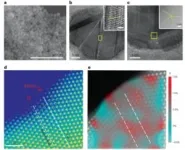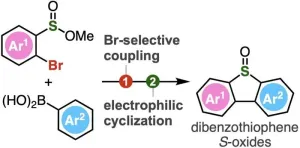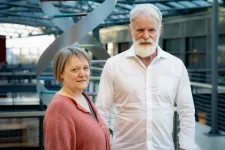(Press-News.org) So how can the speed of dark matter be measured? The prerequisite is to find a galaxy in the universe that moves relative to dark matter. Since everything in the universe is in motion and there is a great deal of dark matter, it is not difficult to find such galaxies.
Heavy objects, like galaxies, attract all types of matter, whether it is dark matter or visible matter that we encounter on a daily basis. As dark matter moves past a galaxy, the galaxy begins to pull the dark matter particles towards it. However, the change of speed direction of the particles takes time. Before their trajectory curves towards the galaxy, they already manage to pass the galaxy.
Thus, dark matter particles do not enter the galaxy, but instead move behind the galaxy (see video). Behind the galaxy, therefore, the density of matter increases, and this leads to a slowdown of the galaxy – a phenomenon called dynamical friction. The strength of dynamical friction, in turn, depends on how quickly dark matter particles pass the galaxy, that is, how long the galaxy has time to change the trajectory of the dark matter particles. When particles pass slowly, the density of matter increases closer to the galaxy, causing it to slow down more.
The green dot represents a galaxy, and the upper panels show the movement of dark matter particles past the galaxy (if a galaxy exists in the corresponding panel). The lower panels show the shape of all the trajectories, demonstrating that the gravity field of a galaxy affects the particles of matter, creating an overdensity behind the galaxy. Overdensity again slows down the galaxy and distorts its shape.
Let us assume that the galaxy causing the dynamical friction is not tiny, but large. In this case, the overdensity behind it generates friction of different strengths at different points in the galaxy, as seen in Figure 1. The difference in friction makes the shape of the galaxy more lopsided. We experience a similar change in shape on Earth as tidal cycles – high tides and low tides caused by the gravity of the moon.
It is irrelevant how big the dark matter particles eventually turn out to be – their orbit still curves behind the galaxy. The method might not produce accurate results if the particles were comparable in size to the galaxies themselves. However, these dark matter models are already excluded.
Finding the lopsided galaxies themselves is not difficult, because they make up about 30 percent of all galaxies in outer space. Of course, a lot depends on how far to look in the outer parts of a galaxy and what level of lopsidedness deems a galaxy lopsided.
Also, the lopsided shape of a galaxy may not be caused only by dynamical friction. There are a number of other reasons for that. For example, galaxies that were formed after the collision of several galaxies may be asymmetric. In this case, however, we should be able to detect somewhere inside the galaxy the nucleus of another galaxy or a larger stellar halo. Galactic lopsidedness can also be caused by a constant inflow of gas. In such situations, the shape of the galaxy will take a few billion years to recover.
Thus, to measure the velocities of dark matter, we need a lopsided galaxy that is as isolated from other galaxies as possible. In this case, it is more certain that nothing has happened to it other than the passage of dark matter.
In this research, we have figured out how to precisely calculate the forces that affect galaxies in tidal cycles. The next stage is to find galaxies sufficiently lopsided in the universe to study the velocity of dark matter relative to the galaxies.
Cosmology is an important test polygon of theoretical physics. Calculating the speed of dark matter can be important for testing new dark matter models and lifting the veil of secrecy over the nature of dark matter.
END
Lopsided galaxies shed light on the speed of dark matter
2024-01-29
ELSE PRESS RELEASES FROM THIS DATE:
Breast cancer test may make bad chemotherapy recommendations for Black patients
2024-01-29
A common test used to decide whether breast cancer patients should get chemotherapy may be making bad recommendations for some Black women, leading them to forgo chemotherapy when it might have helped, according to new research from the University of Illinois Chicago.
The test, known as the 21-gene breast recurrence score, is the most commonly ordered biomarker test used to guide doctor’s recommendations for patients with estrogen receptor-positive breast cancer — the most common ...
First-ever sighting of a live newborn great white
2024-01-29
Great whites, the largest predatory sharks in the world with the most fatal attacks on humans, are tough to imagine as newborn babies. That is partially because no one has seen one in the wild, it seems, until now.
Wildlife filmmaker Carlos Gauna and UC Riverside biology doctoral student Phillip Sternes were scanning the waters for sharks on July 9, 2023, near Santa Barbara on California’s central coast. That day, something exciting appeared on the viewfinder of Gauna’s drone camera. It was a shark ...
Back from the dead: Tropical tree fern repurposes its dead leaves
2024-01-29
CHAMPAIGN, Ill. — Plant biologists report that a species of tree fern found only in Panama reanimates its own dead leaf fronds, converting them into root structures that feed the mother plant. The fern, Cyathea rojasiana, reconfigures these “zombie leaves,” reversing the flow of water to draw nutrients back into the plant.
Watch a video about the findings.
This weird phenomenon occurs only after the leaves die and droop to the ground, said University of Illinois Urbana-Champaign plant biology professor James Dalling, ...
New horizons in chemical biology: A novel approach to synthesize dibenzothiophene s-oxides
2024-01-29
Organic compounds in the field of chemistry range from simple hydrocarbons to complex molecules, with diverse functional groups added to the main carbon backbone. These functional groups impart the compounds distinct chemical properties as well as participate in various chemical transformations, making them important precursors for the synthesis of diverse compounds. Scientists have, therefore, actively engaged in creating molecules that feature novel and highly reactive functional groups.
One such class of compounds are dibenzothiophenes and their derivatives containing ...
Variant in the synaptonemal complex protein SYCE2 associates with pregnancy loss through effects on recombination
2024-01-29
A sequence variant that increases risk of pregnancy loss
Scientists at deCODE genetics, a subsidiary of Amgen and their collaborators from Iceland, Denmark and USA published a study today in Nature Structural and Molecular Biology titled “Variant in the synaptonemal complex protein SYCE2 associates with pregnancy loss through effects on recombination”.
While it is well established that chromosomal abnormalities are a major cause of miscarriages the biology behind pregnancy losses with or without chromosomal errors is not well understood. Over 114 thousand women from Iceland, Denmark, UK, USA and Finland who have ...
How obesity dismantles our mitochondria
2024-01-29
The number of people with obesity has nearly tripled since 1975, resulting in a worldwide epidemic. While lifestyle factors like diet and exercise play a role in the development and progression of obesity, scientists have come to understand that obesity is also associated with intrinsic metabolic abnormalities. Now, researchers from University of California San Diego School of Medicine have shed new light on how obesity affects our mitochondria, the all-important energy-producing structures of our cells.
In a study published January ...
Cancer treatment two and a half times more effective when tumours have defective "energy factories"
2024-01-29
Cancer Research UK-funded scientists have made an unusual discovery that could help to identify patients who are up to two and a half times more likely to respond to currently available cancer drugs.
Scientists at the Cancer Research UK Scotland Institute and Memorial Sloan Kettering Cancer Centre in the USA have “rewired” the DNA of mitochondria – energy factories found in every living cell. They found that creating mutations in parts of this DNA determines how well cancer will respond to immunotherapy – treatments which harness the body’s natural defences ...
How does a “reverse sprinkler” work? Researchers solve decades-old physics puzzle
2024-01-29
For decades scientists have been trying to solve Feynman’s Sprinkler Problem: How does a sprinkler running in reverse—in which the water flows into the device rather than out of it—work? Through a series of experiments, a team of mathematicians has figured out how flowing fluids exert forces and move structures, thereby revealing the answer to this long-standing mystery.
“Our study solves the problem by combining precision lab experiments with mathematical modeling that explains how a reverse sprinkler operates,” explains Leif Ristroph, an associate professor at New York University’s Courant Institute of Mathematical Sciences and the senior author ...
Neuroblastoma: Liquid biopsies to detect relapse of childhood cancer early
2024-01-29
(Utrecht/Vienna, 29.1.2024) Neuroblastoma mainly affects toddlers and young children - in the EU region there are 1500 new cases per year. Neuroblastoma is a malignant tumor of the peripheral nervous system and around 50% of patients are high-risk cases. Recurrences occur frequently, and conventional therapies are no longer effective for these children. With liquid biopsies it is possible to monitor therapy success and to predict the recurrence of the tumor in time to take medical countermeasures. Scientists from leading European ...
Speaking in a local accent might make social robots seem more trustworthy and competent
2024-01-29
Social robots can help us with many things: teaching, learning, caring. Because they’re designed to interact with humans, they’re designed to make us comfortable — and that includes the way they talk. But how should they talk? Some research suggests that people like robots to use a familiar accent or dialect, while other research suggests the opposite.
“Surprisingly, people have mixed feelings about robots speaking in a dialect — some like it, while others prefer standard language,” said Katharina Kühne of the University of Potsdam, lead author ...









